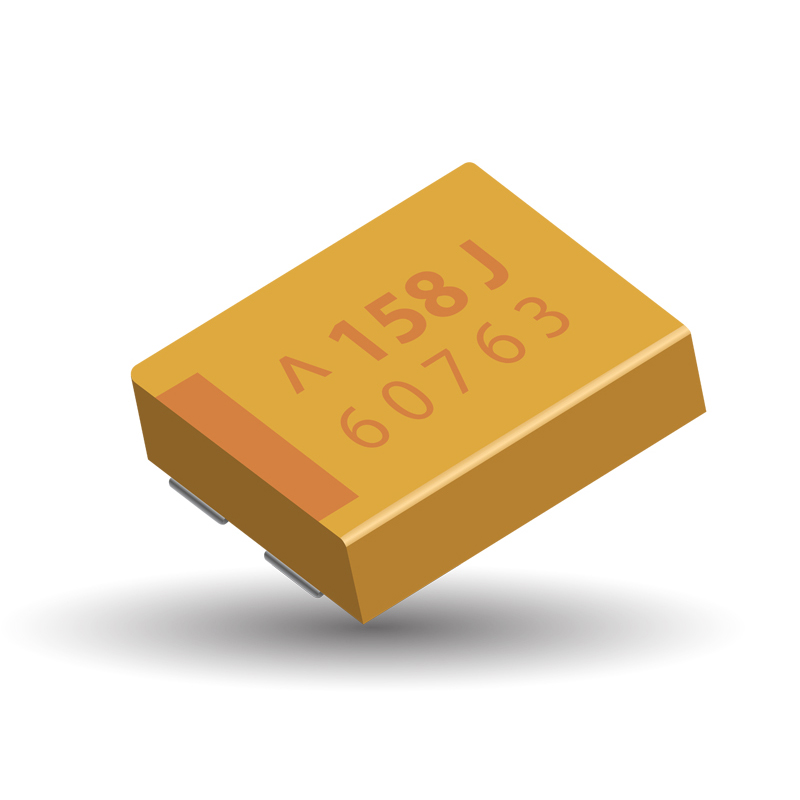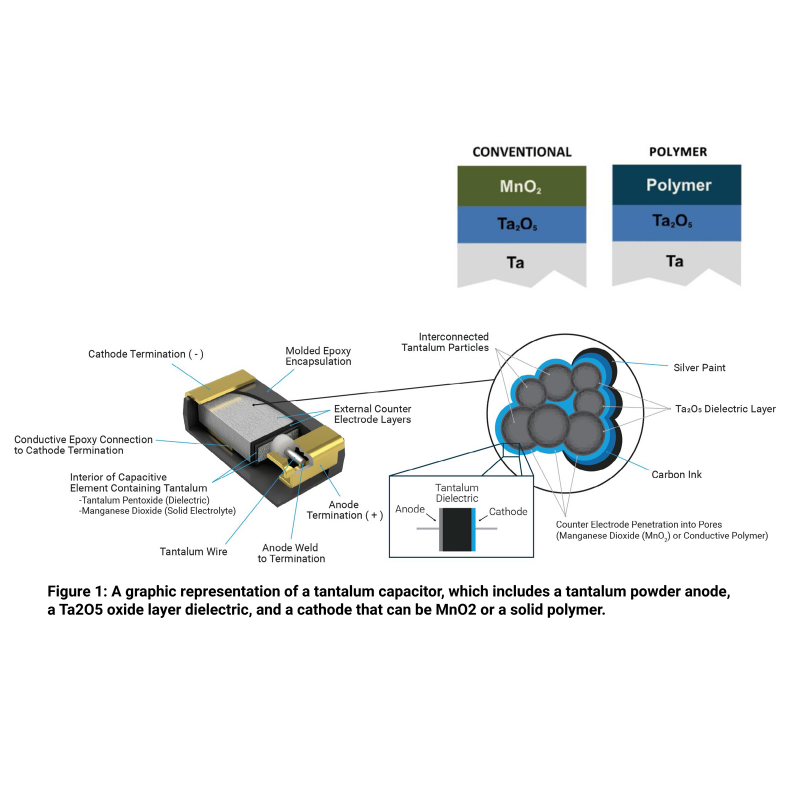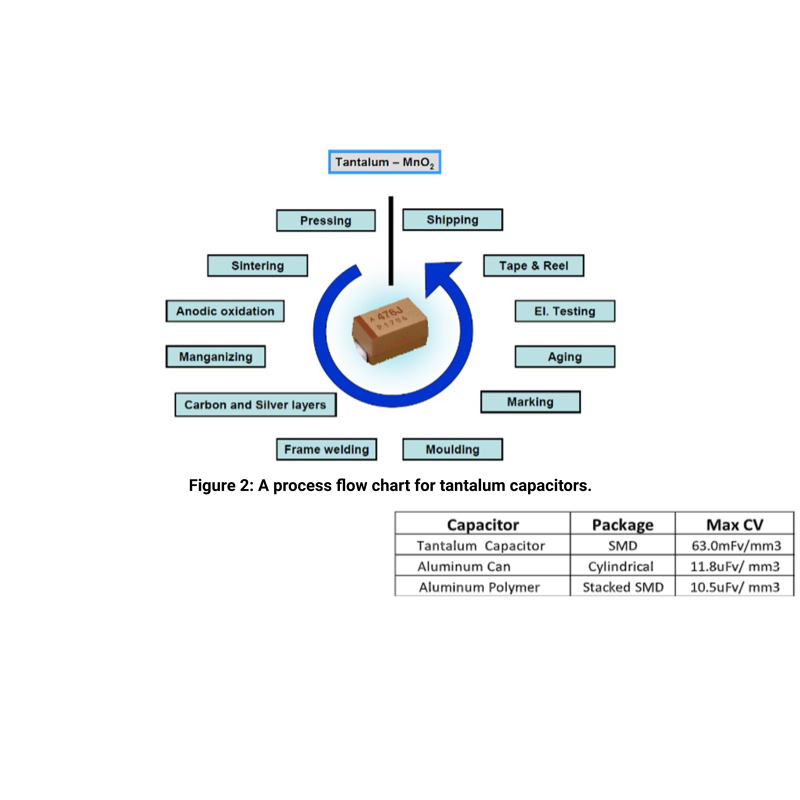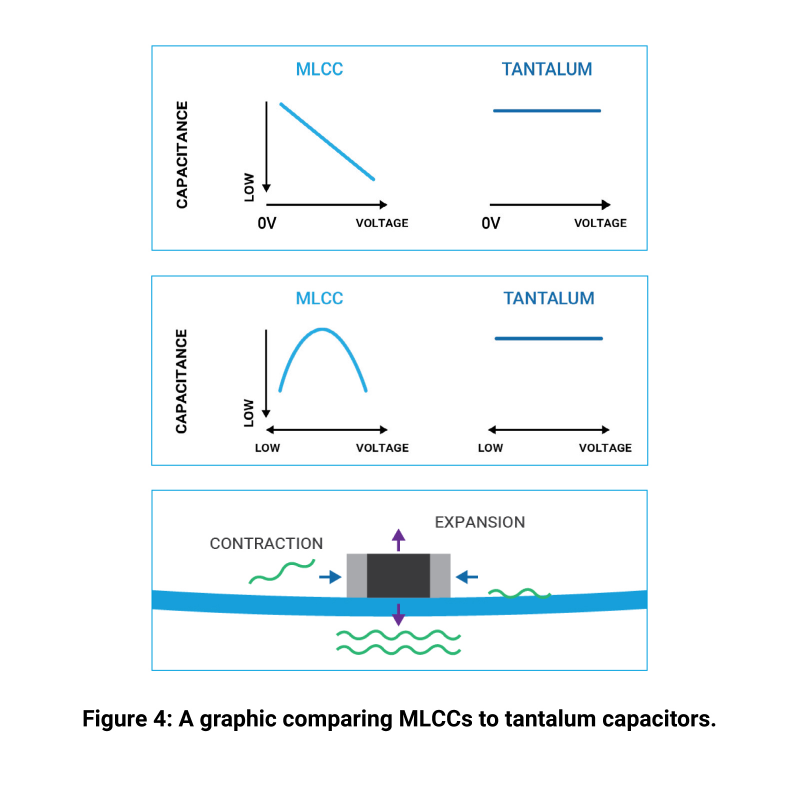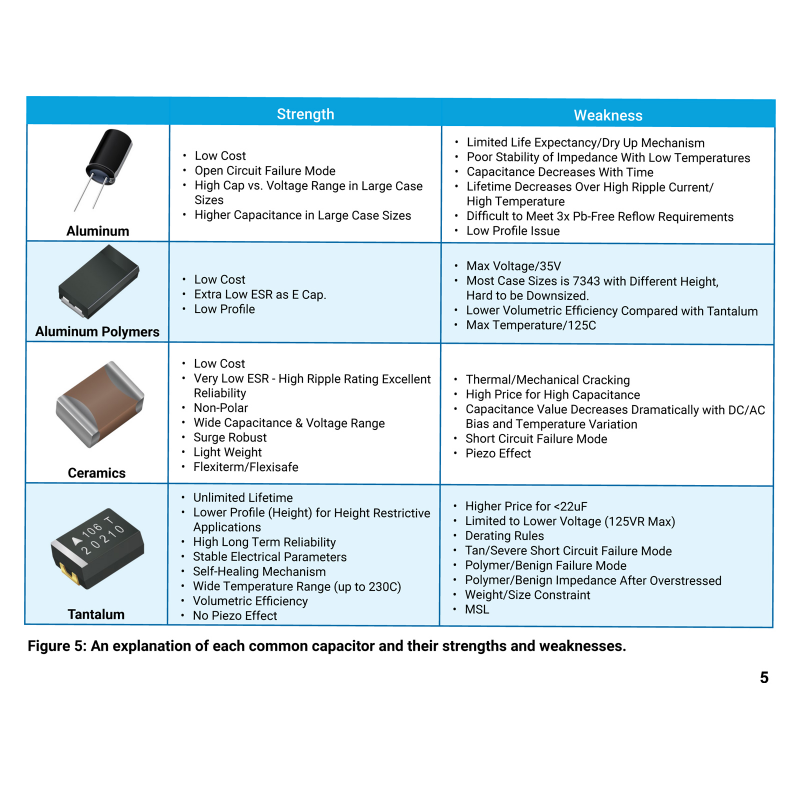Tantalum Capacitors: Characteristics & Component Selection
Capacitors are one of the fundamental building blocks of electrical circuits. Whether they are being used for energy storage, noise filtering, or timing/frequency design, capacitors are important in many common electrical devices.
Today, various capacitor technologies are available, each with their own unique benefits and drawbacks, making each type ideal for different applications.
Tantalum capacitors offer many interesting characteristics that combine to offer a unique solution to many design problems.
Introduction
Tantalum capacitors are capacitors constructed with tantalum material used to form the anode of the capacitor.
Tantalum capacitors are electrolytic capacitors, which means the capacitor is formed by an oxide layer formed on the anode and is thus polarized.
A tantalum capacitor includes a tantalum powder anode, a Ta2O5 oxide layer dielectric, and a cathode that can be MnO2 or a solid polymer.
Tantalum capacitors are made by pressing the tantalum powder and forming it into a pellet through sintering.
Tantalum capacitors are beneficial because they form an extremely thin dielectric, as little as 20 - 400 nm thick. This pellet is porous, like a solid sponge, so when the dielectric layer is formed in the next step (anodic oxidation), the thin oxide layer is formed over a great deal of surface area. This allows tantalum capacitors to have a much higher capacitance and voltage per volume (CV/cc) than other technologies
Tantalum capacitors offer max CV values many times higher than typical capacitor technologies commonly used today.
Comparing Tantalum to Other Common Capacitor Technologies
Tantalum vs Aluminium Can Capacitors
The primary structural difference between tantalum and aluminium can capacitors (other than the materials used) is the electrolyte. The electrolyte is a solid material in a tantalum capacitor, and a liquid in an aluminium can capacitor.
The conductivity of the liquid electrolyte is very dependent on temperature, meaning all of the critical parameters of aluminium can capacitors (capacitance, ESR, leakage current, DF, and even rated voltage) are unstable over broader temperature ranges. The liquid electrolyte can even dry out over time, resulting in a shorter expected lifetime.
By contrast, tantalum capacitors utilize a solid electrolyte that does not dry out, is much more stable over temperature, and has a significantly longer life expectancy
Tantalum vs MLCC
Multi-layer ceramic capacitors (MLCC) are nonpolarized capacitors that are prevalent surface mount components in many designs. MLCC devices have some drawbacks, which can make tantalum capacitors a better option in many systems.
First, ceramic materials have a piezo-electric effect, so MLCC devices share this characteristic. Materials with piezo-electric characteristics physically move or vibrate when electrical signals are applied, and/or create electrical signals when physical pressure is applied. This effect can cause ceramic capacitors to “sing” or “hum” when electrical signals are used, varying by frequency harmonics. Tantalum capacitors do not have a piezo-electric effect.
Next, MLCC devices have a DC bias characteristic, meaning the actual capacitance of the capacitor varies with the voltage level applied to the capacitor. Tantalum capacitors are not susceptible to DC bias.
Finally, as mentioned above, all of the tantalum capacitors’ parameters are very stable over a wide range of temperatures, from -55 to 125°C, and even up to 175°C. MLCC devices have many different grades for different temperature groupings, such as X5R, X7R, and NP0. Tantalum capacitors, being stable over wide ranges of temperatures, do not.
DC Bias Voltage - In an MLCC, capacitance decreases as bias voltage applied increases. Tantalum capacitors do not vary with bias voltage, and they are physically smaller than the same capacitance MLCC devices.
Temperature - In an MLCC, capacitance is susceptible to temperature, decreasing at low and high temperatures. Tantalum capacitors show stable capacitance across all rated temperatures.
AC Voltage (Noise) - In an MLCC, the substrate vibrates when an AC voltage or noise is applied. This vibration can cause audible noise. Tantalum substrates do not vibrate, so they cannot create audible noise.
Tantalum vs Aluminium Polymer
Aluminium polymer capacitors generally use the materials of the aluminium can capacitors, but replace the liquid electrolyte with a solid polymer material. This solid polymer reduces the ESR of these capacitors to the mOhms range, while at the same time providing greater stability of the parameters over temperature, time, voltage, and frequency.
While aluminium polymer capacitors offer technology improvements over traditional aluminium can capacitors, tantalum capacitors still offer some superior parameters.
First, tantalum capacitors can achieve even higher CV due to its porous structure. Second, tantalum capacitors can achieve even lower ESR because of their internal structure with parallel layers and multiple anodes. Finally, tantalum capacitors are more resistant to vibration, which is especially important for automotive applications.
In summary, tantalum capacitors offer many technological advantages over other standard capacitors available today.
Tantalum Capacitor Variants
MnO2 Tantalum
The manganese dioxide tantalum capacitor is the conventional tantalum capacitor construction.
MnO2 tantalum capacitors are suitable in terms of stability, reliability and long lifetime. They have no DC bias, no piezo effect, and good volumetric efficiency for applications where space is limited.
These parts are used in high-end applications, such as precision equipment, industrial control, medical, military, & aerospace.
Polymer Tantalum
Polymer tantalum capacitors are used in new and emerging technologies where the application requires additional safety and low ESR. For example, in portable or handheld devices, safety is a primary concern, while low ESR helps to reduce the size of the circuit implementation and extend battery life. The low ESR also reduces internal heating and extends the lifetime.
Niobium Oxide Tantalum
Niobium oxide tantalum capacitors, branded Oxicap® by AVX, offers improved failure mode safety. In the worst-case failure mode, niobium oxide tantalum capacitors fail open, rather than short, which creates a much safer failure mode, preventing severe circuit damage or even fire.
In application designs requiring extreme conditions or safe failure, these are the ideal choice. They are limited by rated voltage, with current maximum voltage rating for AVX’s Oxicap® topping out at 10V.
Example applications include portable devices, petroleum, natural gas, and other applications that might be very sensitive to flames.
Application Information for Tantalum Capacitors
Deratings
Generally, polymer and niobium oxide capacitors are voltage derated by 20%, while MnO2 capacitors are derated by 50%. These derating considerations are based on surge or inrush currents.
If the applied voltage to a polymer or niobium oxide capacitor is 10V or lower, a 10% derating can be used. For assistance with determining the proper derating in your design, and calculating the MTBF and FITS data for your application and given deratings, the DMTL & AVX teams can help provide more details, including simulation tools and MTBF calculation formulas.
MnO2 Tantalum Applications
For most electrical circuit applications, MnO2 tantalum capacitors are a good choice. They have been proven in use for several decades, so their characteristics and reliability are well understood. They have a high volumetric efficiency (CV) and very stable parameters. MnO2 tantalums are suitable for consumer-grade applications requiring a small physical size and low noise, such as audio and video equipment.
They are also useful as a substitute for aluminium can capacitors for industrial applications with long life expectations because they do not dry out.
They are also ideal for higher temperature applications such as automotive ECU or fan control, where temperature ratings need to be 150° or 175°C. Because of the potential for a short circuit failure mode, if that failure will be catastrophic in an application a 50% voltage derating is recommended for MnO2 capacitors.
Large scale production testing has validated the benefit of derating.
Polymer Tantalum Applications
Polymer tantalum capacitors have extremely low ESR and a benign failure mechanism, meaning no catastrophic damage is caused. These capacitors are ideal for consumer applications, along with some industrial applications.
Due to their low ESR, polymer tantalums are useful for high current applications and those that require low ripple voltage. For example, 5G partial power supply, GPU, AI, GaN Fast Charger, and some LED lighting applications. These components are also useful for portable devices such as tablets, smartphones, wearable devices, and portable medical devices, thanks to their low noise, small size, and safe operation.
With the undertab concept structure, polymer tantalum has a lower thickness, which can be applied to some low profile applications, like ESSD, ultrasound fingerprint identification module.
Polymer tantalum capacitors can be sensitive to moisture and temperature, somewhat limiting their application. Most of them are moisture sensitivity level 3 (MSL3), so they require strict controls on the production line.
AVX has developed unique processes to develop an enhanced automotive level polymer tantalum capacitor. This is a huge leap forward in technology, making these parts ideal for automotive applications. Based on this new technology, polymer tantalums are now also available for high-reliability applications, like aerospace, military, and COTS-Plus.
Niobium Oxide Tantalum Applications
Niobium Oxide capacitors are used in safety applications. They fail open, high impedance, even after overstressing. Niobium Oxide capacitors are suitable for applications where the voltage is under 10v, like most digital circuits. They also have an option with ultra-low ESR to match up with chipset ports.
Niobium Oxide capacitors can be used as an alternative for MnO2 tantalum capacitors. They have similar electrical and mechanical parameters but offer the improved failure mode safety operation.

